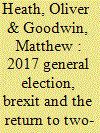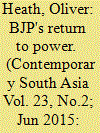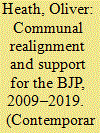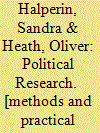|
|
|
Sort Order |
|
|
|
Items / Page
|
|
|
|
|
|
|
| Srl | Item |
| 1 |
ID:
149204


|
|
|
|
|
| Summary/Abstract |
Why did Britain vote for Brexit? What was the relative importance of factors such as education, age, immigration and ethnic diversity? And to what extent did the pattern of public support for Brexit across the country match the pattern of public support in earlier years for eurosceptic parties, notably the UK Independence Party (UKIP)? In this article we draw on aggregate-level data to conduct an initial exploration of the 2016 referendum vote. First, we find that turnout was generally higher in more pro-Leave areas. Second, we find that public support for Leave closely mapped past support for UKIP. And third, we find that support for Leave was more polarised along education lines than support for UKIP ever was. The implication of this finding is that support for euroscepticism has both widened and narrowed—it is now more widespread across Britain but it is also more socially distinctive.
|
|
|
|
|
|
|
|
|
|
|
|
|
|
|
|
| 2 |
ID:
155401


|
|
|
|
|
| Summary/Abstract |
The outcome of the 2017 general election—a hung parliament—defied most predictions. In this article, we draw on aggregate-level data to conduct an initial exploration of the vote. What was the impact of Brexit on the 2017 general election result? What difference did the collapse of UKIP make? And what was the relative importance of factors such as turnout, education, age and ethnic diversity on support for the two main parties? First, we find that turnout was generally higher in more pro-remain areas, and places with high concentrations of young people, ethnic minorities and university graduates. Second, we find that the Conservatives made gains in the sort of places that had previously backed Brexit and previously voted for UKIP. But, third, we find that the gains the Conservatives made from the electoral decline of UKIP were offset by losses in the sort of places that had previously supported the Conservatives, particularly areas in southern England with larger numbers of graduates. The implication of these findings is that while a Brexit effect contributed to a ‘realignment on the right’, with the Conservative strategy appealing to people in places that had previously voted for UKIP, this strategy was not without an electoral cost, and appears to have hurt the party in more middle class areas.
|
|
|
|
|
|
|
|
|
|
|
|
|
|
|
|
| 3 |
ID:
139625


|
|
|
|
|
| Summary/Abstract |
Using constituency-level data, the article examines the BJP's vote swing at the State and Constituency level in India. Drawing on theories of electoral realignment, I examine the BJP's performance at the constituency level and investigate the extent to which the party drew voters from other parties (particularly Congress), mobilised new voters (via increased turnout), and appealed to the newly enfranchised (via increases in the size of the electoral roll). The results of the analysis show that the key to the BJP's success was its ability to mobilise new voters in places where it had previously not fared so well.
|
|
|
|
|
|
|
|
|
|
|
|
|
|
|
|
| 4 |
ID:
173328


|
|
|
|
|
| Summary/Abstract |
To what extent has the BJP managed to capture the rural vote? And how does the party’s level of support relate to poverty and literacy? Is the Hindu-Muslim divide becoming more pronounced – or has it faded as the party seeks to broaden its appeal? Using constituency level data linked to census data, this article examines support for the BJP and patterns of social realignment at the constituency level from 2009 to 2019. In particular, I examine the impact of social cleavages related to the level of urbanisation, poverty, and literacy within a constituency, as well as its religious and caste profile. Using OLS regression with state-level fixed effects I present a detailed analysis of the social profile of places where the BJP has prospered over the last ten years and the major socio-geographical fault lines that run through the country. The results show that over the last three election cycles support for the BJP has become increasingly polarised along communal lines.
|
|
|
|
|
|
|
|
|
|
|
|
|
|
|
|
| 5 |
ID:
114515


|
|
|
|
|
| Publication |
Oxford, Oxford University Press, 2012.
|
| Description |
xiv, 440p.Pbk
|
| Standard Number |
9780199558414
|
|
|
|
|
|
|
|
|
|
|
|
Copies: C:1/I:0,R:0,Q:0
Circulation
| Accession# | Call# | Current Location | Status | Policy | Location |
| 056784 | 320.072/HAL 056784 | Main | On Shelf | General | |
|
|
|
|
|
|
|
|
|